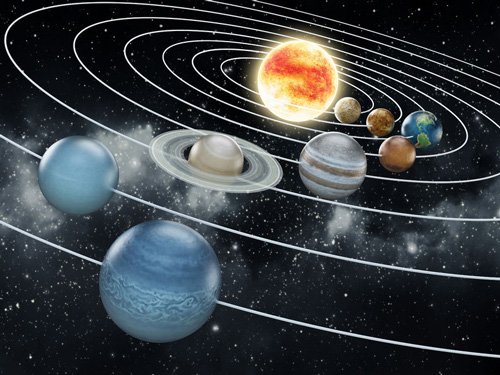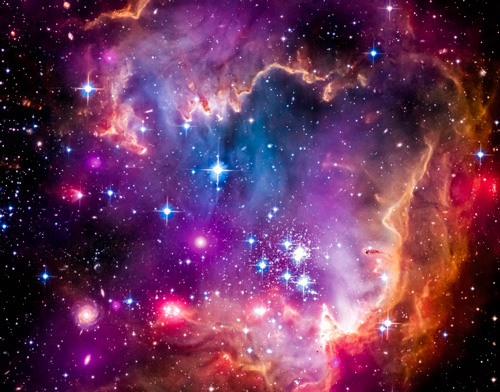Reading Comprehension Text and Exercises
Planets of Our Solar System
The planet we live on is called Earth. Earth goes around a star called the Sun, and as such classifies as a planet.
The Sun and everything that circles it form together a system called the solar system (solar = of the sun). In our solar system, there are additional seven planets, and dwarf planets (planetary objects which do not qualify as planets).
Each of these planets takes a different amount of time to travel around the Sun. For the Earth, this journey is 365.25 days long, but for a faraway planet like Neptune, it takes 165 years. There are smaller objects which do not circle the Sun, but around these planets. They are called satellites, or moons, just like Earth's only natural satellite.

Click Here for Step-by-Step Rules, Stories and Exercises to Practice All English Tenses
Mercury
The planet closest to the Sun is named after Mercurius, a Roman god. Being a messenger god, Mercurius moves around quickly, so his name was a good fit for this planet because it travels the shortest amount of time around the Sun.
Because it is so close to the Sun, Mercury is a really hot planet. During the day, the temperature can go up to 840 °F (450 °C). However, at night, the planet cools down quickly, and the temperature drops to – 290 °F (-180°C).
Mercury has a huge iron core, and a very thin atmosphere (a mixture of gases around a planet). It can sometimes be seen from Earth.
Venus
Venus is the Roman goddess of love. The second planet in our solar system was considered to be the brightest object in the sky and one of the most beautiful sights, and this is why this goddess was chosen for its name.
This is a rocky planet with very thick clouds which prevent us from seeing its surface. Certain radars have detected multiple volcanoes on Venus. One such volcano is Maat Mons. This 5.6 mile (9km)-tall volcano is constantly surrounded by lava, hot liquid rock, due to its regular activity. Venus can sometimes be even warmer than Mercury.
Earth
Our planet Earth is the only planet which was not named after a god or a goddess. In Latin, our planet is known as Terra, meaning "the ground". Terra is also the name of the Roman goddess of the earth. Gaia, deriving from the Greek Ge, meaning "land", is the Greek goddess of the earth.
Instead of Terra or Gaia, the modern term "Earth" was preferred. It developed from an Old English noun eorðe, which also means "the ground".
Unlike all other planets in our solar system, Earth is the only one which has the right conditions for life. There are oxygen and water, and the temperature is warm enough, thanks to which millions of species live on our planet.
Mars
Mars is known as the Red Planet. What makes it so bright red is rust, a reddish-brown substance that forms on iron, is in its soil. However, when it came to naming the planet, people associated the red color with blood and war, which is why borrowed its name from the Roman god of war.
Water on Mars has been frozen into rocks, so there is a suspicion there could be primitive life forms on this planet. We also know that strong winds, which cover the entire planet in dust, frequently occur on Mars.
Jupiter
Jupiter is the largest planet in our solar system. It is 11 times wider than Earth. For this reason, both the Greeks and the Romans named it after their supreme gods. In Greek, this planet was known as Zeus, while the Romans called it Jupiter.
This planet has many moons. Four largest ones were discovered by Galileo Galilei, an Italian astronomer, in 1610. The smallest of them, called Europa, is covered in ice, so scientists believe this satellite may support some life forms.
Saturn
In Roman mythology, Saturn is a version of the Greek God Cronos, Zeus' father and god of agriculture. This planet has a large number of satellites (53 of them).
Most of them were named after Titans, brothers and sisters of Saturn in Greek mythology. The largest moon, called Titan is even bigger than Mercury.
This planet is recognizable by its system of seven shining rings which circle the equator, the line which is half-distance between two poles. They look solid, but in fact they are scattered pieces of rock and ice.
Uranus
The sixth planet, Uranus, was discovered in 1781 by a British astronomer Willian Herschel. Upon this event, Uranus became the first planet to be discovered with a telescope, a device which makes faraway objects look closer and larger.
Herschel wanted to name the planet after King George III, who was then the ruling monarch of the British Empire. Nevertheless, in the same year, the planet was named Uranus, after the Greek god of the sky, and the father of Saturn. Uranus has 27 moons.
Neptune
Johann Gale, a German astronomer, was the first to observe the eighth planet in 1846. The international astronomical community decided to give this planet a Roman name after the god of the sea. At that time, it was believed that Neptune was the furthest planet in the solar system, watching over the "sea" that we called the space.
Out of all the planets in our solar system, Neptune has the most powerful hurricanes. Its winds blow at speeds up to 750 miles (1200 km) per hour. Due to the presence of methane gas, this planet appears to be deep blue.
Pluto
Pluto is the god of the underworld, living in a dark and cold place. Being so far away from the Sun, this dwarf planet is supposed to be very dark as well. Temperatures are as low as -369 F (-223 C), and it takes Pluto 247.7 years to travel around the Sun.
Pluto was the last planet to be discovered. In 1930, it was spotted by a US astronomer Clyde Tombaugh. In recent years, there has been a disagreement about Pluto's status, which is why it was declassified. Because it is small and different from other planets, it is considered to be one of the five "dwarf" planets, but not everyone supports this opinion.

Comprehension Exercises
Vocabulary Questions
- What does "radar" mean?
- system that can find the position of objects which cannot be seen
- tool used to measure the dimensions of objects
- group of scientists
- What does "suspicion" mean?
- feeling that something is impossible
- feeling that something may be true
- knowing that something happened
- What does "scattered" mean?
- standing close to each other
- covering a wide area, disordered
- false, appearing to be true
- What does "solid" mean?
- firm, stable in shape
- liquid, fluid
- valuable, worthy
- What does "primitive" mean?
- highly developed
- the most important
- very basic
Collocation Questions
- Earth is the only planet with the right ___________ for life.
- situation
- conditions
- context
- The Moon is our planet's only ___________ satellite.
- natural
- real
- native
- Saturn's rings are scattered ___________ of rock and ice.
- bits
- scraps
- pieces
- Scientists believe Europa may support some life ___________.
- forms
- shapes
- structures
- The name "Mars" was borrowed ___________ the Roman god of war.
- by
- from
- of
- Some radars can ___________ volcanoes on Venus.
- spot
- note
- detect
- Neptune is ___________ planet.
- an outlying
- a faraway
- a distant
- There might be ___________ life forms on Mars.
- unrefined
- elementary
- primitive
- Neptune has the most ___________ hurricanes.
- powerful
- forceful
- mighty
- Strong winds frequently ___________ Mars in dust.
- surround
- cover
- enfold
Wh Questions
- How was Uranus discovered?
- with a radar
- with a spaceship
- with a telescope
- Where does the name "Earth" come from?
- Old English
- Latin
- Greek
- Why do scientists believe there might be life on Mars?
- because people believe in aliens
- because there is frozen water
- because Mars has the right conditions for life
- What makes Neptune look so blue?
- a big ocean
- the clouds
- a gas
- Which planet is the largest?
- Earth
- Jupiter
- Neptune
Evaluating Statements
- Based on the information in this lesson, which statement is true?
- Galileo Galilei discovered Jupiter.
- Galileo Galilei discovered several Jupiter's satellites.
- Based on the information in this lesson, which statement is false?
- Everybody agrees that Pluto is a planet.
- Nowadays, most people think Pluto is not a real planet, but a "dwarf" planet.
True or False?
- Based on the information in this lesson, is the following statement true or false?
"The temperature on Mercury is always high." - True
- False
- Based on the information in this lesson, is the following statement true or false?
"In Greek mythology, there is a goddess of the earth called Gaia, but this name was not chosen for our planet." - True
- False
Answer Key
1. A | 2. B | 3. B | 4. A | 5. C | 6. B | 7. A | 8. C | 9. A | 10. B | 11. C | 12. B | 13. C | 14. A | 15. B | 16. C | 17. A | 18. B | 19. C | 20. B |21. B | 22. A | 23. B | 24. A
Get Updates, Special Offers, and English Resources
Download your FREE GIFT (the first two chapters of
English Short Stories Book and Workbook)
as soon as you join!

By submitting your email, you consent to receiving updates and newsletters from us and to the sharing of your personal data with third parties for the purposes of sending you communications. We will not spam you. You can unsubscribe at any time. For more information, please see our privacy policy.





